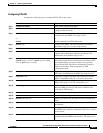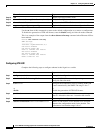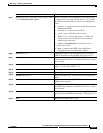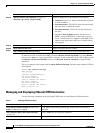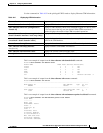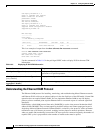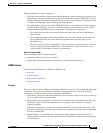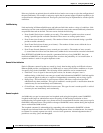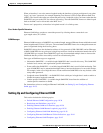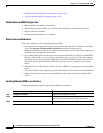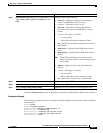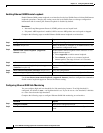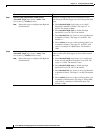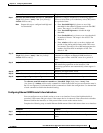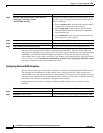
10-35
Cisco ASR 901 Series Aggregation Services Router Software Configuration Guide
OL-23826-09
Chapter 10 Configuring Ethernet OAM
When an interface is set to the remote loopback mode the interface no longer participates in any other
Layer 2 or Layer 3 protocols; for example Spanning Tree Protocol (STP) or Open Shortest Path First
(OSPF). The reason is that when two connected ports are in a loopback session, no frames other than the
OAM PDUs are sent to the CPU for software processing. The non-OAM PDU frames are either looped
back at the MAC level or discarded at the MAC level.
From a user's perspective, an interface in loopback mode is in a link-up state.
Cisco Vendor-Specific Extensions
Ethernet OAM allows vendors to extend the protocol by allowing them to create their own
type-length-value (TLV) fields.
OAM Messages
Ethernet OAM messages or OAM PDUs are standard length, untagged Ethernet frames within the normal
frame length bounds of 64 to 1518 bytes. The maximum OAM PDU frame size exchanged between two
peers is negotiated during the discovery phase.
OAM PDUs always have the destination address of slow protocols (0180.c200.0002) and an Ethertype
of 8809. OAM PDUs do not go beyond a single hop and have a hard-set maximum transmission rate of
10 OAM PDUs per second. Some OAM PDU types may be transmitted multiple times to increase the
likelihood that they will be successfully received on a deteriorating link.
Four types of OAM messages are supported:
• Information OAM PDU—A variable-length OAM PDU that is used for discovery. This OAM PDU
includes local, remote, and organization-specific information.
• Event notification OAM PDU—A variable-length OAM PDU that is used for link monitoring. This
type of OAM PDU may be transmitted multiple times to increase the chance of a successful receipt;
for example, in the case of high-bit errors. Event notification OAM PDUs also may include a time
stamp when generated.
• Loopback control OAM PDU—An OAM PDU fixed at 64 bytes in length that is used to enable or
disable the remote loopback command.
• Vendor-specific OAM PDU—A variable-length OAM PDU that allows the addition of
vendor-specific extensions to OAM.
For instructions on how to configure Ethernet Link OAM, see Setting Up and Configuring Ethernet
OAM, page 10-35.
Setting Up and Configuring Ethernet OAM
This section includes the following topics:
• Default Ethernet OAM Configuration, page 10-36
• Restrictions and Guidelines, page 10-36
• Enabling Ethernet OAM on an Interface, page 10-36
• Enabling Ethernet OAM Remote Loopback, page 10-38
• Configuring Ethernet OAM Link Monitoring, page 10-38
• Configuring Ethernet OAM Remote Failure Indications, page 10-41
• Configuring Ethernet OAM Templates, page 10-42



